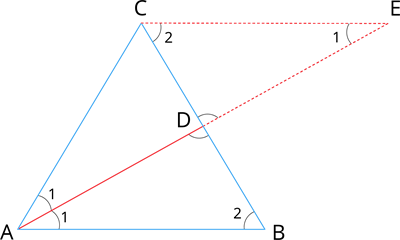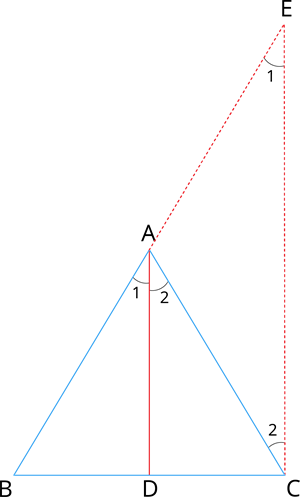UPSKILL MATH PLUS
Learn Mathematics through our AI based learning portal with the support of our Academic Experts!
Learn moreAngle Bisector theorem
Statement: The internal bisector of an angle of a triangle divides the opposite side internally in the ratio of the corresponding sides containing the angle.

Given: In \triangle ABC, AD is the internal bisector.
To prove: \frac{AB}{AC} = \frac{BD}{CD}
Construction: Draw a line through C parallel to AB. Extend AD to meet line C at E.
Proof: Here, CE and AB are two parallel lines cut by a transversal line AE.
Then, \angle AEC = \angle BAE = \angle 1 [Alternate angles are equal]
Since AD is the angle bisector, then \angle BAD = \angle DAC
In \triangle ACE, \angle CAE = \angle CEA
Therefore, \triangle ACE is isosceles.
Thus, AC = CE ---- (1)
By AA similarity, we have:
\triangle ABD \sim \triangle ECD
\frac{AB}{CE} = \frac{BD}{CD}
\frac{AB}{AC} = \frac{BD}{CD} [Using equation (1)]
Hence, we proved.
The converse of the angle bisector theorem
Statement: If a straight line through one vertex of a triangle divides the opposite side internally in the ratio of the other two sides, then the line bisects the angle internally at the vertex.

Given: ABC is a triangle. AD divides BC in the ratio of the sides containing the angles \angle A to meet BC at D.
That is, \frac{AB}{AC} = \frac{BD}{DC} ---- (1)
To prove: AD bisects \angle A. That is, \angle 1 = \angle 2
Construction: Draw CE \parallel DA. Extend BA to meet at E.
Proof: Let us assume \angle BAD = \angle 1 and \angle DAC = \angle 2.
Since DA \parallel CE and AC is the transversal, then, we have:
\angle BAD = \angle AEC = \angle 1 [Corresponding angles are equal]
\angle DAC = \angle ACE = \angle 2 [Alternate angles are equal]
Consider \triangle BCE. By Thales theorem, we have:
\frac{BA}{AE} = \frac{BD}{DC} ---- (2)
From equations (1) and (2), we have:
\frac{AB}{AC} = \frac{BA}{AE}
AC = AE [Cancelling AB] ---- (3)
Therefore, \triangle ACE is isosceles by equation (3).
\Rightarrow \angle 1 = \angle 2
Since \angle BAD = \angle 1 and \angle DAC = \angle 2, then AD bisects \angle A.
Hence, we proved.